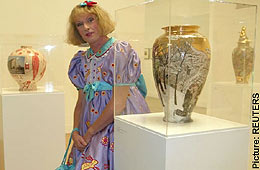#Reith lectures ask if art can still get the jaded 21st century all shook up?
Can art still shock the jaded 21st century Grayson Perry will ask today in the third of his BBC Reith Lecture series. It’s a good question, one that Mr Perry alias the elaborately made-up, frock-wearing Claire, is surely well placed to answer. At least to the extent that the artist is shocking but his art fairly conventional.
Mr Perry, a transvestite potter (the only visual artist and the only transvestite ever to deliver the Reith Lecctures) won’t stand for that. In his second lecture (the transcript is available to read here), he was dubious about the ‘artist’ being the artwork, if at all they could be said to be artists at all. He appeared to challenge art historian Ernst Gombrich’s declaration that “There is no such thing as art, only artists.”
As Mr Perry recounted, this year, Oscar-winning actress Tilda Swinton replicated conceptual artist Cornelia Parker’s 1995 ‘The Maybe’, which originally had Ms Swinton asleep in a glass box in the Serpentine in London. Now, Ms Swinton has put the glass box in the Museum of Modern Art in New York, and Mr Perry confessed to being bemused. “I thought she was the artwork a bit, but maybe she wasn’t. But is she an artist?” he asked.
It was yet another question in a provocative lecture that addressed the most pressing issues about a world where anything goes. Can a urinal be a work of art? A pile of sweets on a gallery floor? Is the handbags and hipster test important when deciding what is art?
You see, Mr Perry’s lecture was titled “beating the bounds” and he suited action to word in a remarkably inventive recreation for the art world of the ancient English custom. In the age before cartography, a community would walk the edges of their parish, beat the bounds and commit the parameters to memory. So it was with Mr Perry. He beat the bounds of today’s art world. But I’m not sure he left the edges all that well defined. Or if they can ever be.


